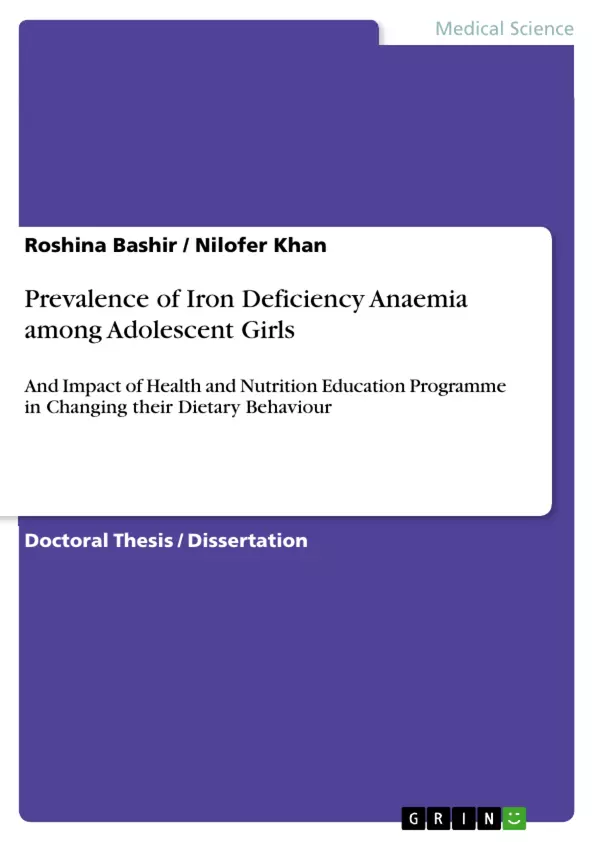The present study was conducted to determine the prevalence of iron deficiency anaemia among adolescent girls and impact of health and nutrition education programme in changing their dietary behaviour. A sample of 200 adolescent girls was selected from different government schools of district Srinagar in order to arrive at dependable conclusion. A structured interview schedule was prepared and simple language was used but still in some schools questions had to be explained in local Kashmiri language to obtain appropriate information from the respondents. The study reveals that:
1. While analyzing the heights (cm) for adolescent girls both in normal and anaemic group it was found that there is statistically significant difference between the adolescent girls of particular age group (15 years) and recommended values. In case of weights (kg) there is insignificant difference between the adolescent girls and recommended values.
2. The BMI analysis of adolescent girls showed that 64.7% of the subjects had low weight, 56.9% had normal weight and 33.3% subjects were overweight.
3. Majority of the adolescent girls were found to be anemic. The baseline hemoglobin level of the adolescent girls was 9.8±1.7g%. After three months of intervention of Health and Nutrition Education Programme, the hemoglobin levels were increased and the levels were between 10.4±1.4g%.
4. The clinical assessment of the adolescent girls showed the signs of nutritional deficiencies. The menstrual history of adolescent girls showed 57.1% of the subjects were of the age of 12 years or more. 57.8% of the adolescent girls belonged to the category that had duration of flow for 3-4 days. 59.1% of the subjects had menstrual cycle duration of 28 days where as 55.6% had less than 28 days. It was observed that 58.1% of the subjects had regular menarche and 44.0 % had irregular menarche periods. Majority of the adolescent girls did not have history of past illnesses.
5. It was concluded that majority of the adolescent girls (56.6%) had iron deficiency anaemia.
Inhaltsverzeichnis (Table of Contents)
- ABSTRACT
- INTRODUCTION
- Risk Factor of Anaemia
- Causes of Anaemia
- Stages of Anaemia
- Nutritional Requirement during Adolescents
- Objectives of the Study
- REVIEW OF LITERATURE
- RESEARCH METHODOLOGY
- Material Selection
- Development of Questionnaire
- Clinical and Bio Chemical Assessment
- Nutrition Education
- Procedure
- RESULTS
- DISCUSSION
- CONCLUSION AND RECOMMENDATIONS
- BIBLIOGRAPHY
- APPENDIX
Zielsetzung und Themenschwerpunkte (Objectives and Key Themes)
This research aims to investigate the prevalence of iron deficiency anemia among adolescent girls and the impact of a health and nutrition education program on their dietary behavior. The study seeks to determine the effectiveness of this intervention in addressing iron deficiency anemia and promoting healthier dietary practices among this population.
- Prevalence of Iron Deficiency Anemia in Adolescent Girls
- Dietary Behavior of Adolescent Girls
- Impact of Health and Nutrition Education Programs
- Effectiveness of Intervention Strategies
- Factors Contributing to Anemia and Dietary Habits
Zusammenfassung der Kapitel (Chapter Summaries)
The research begins by exploring the various risk factors and causes of iron deficiency anemia, emphasizing its prevalence in adolescence. The study also analyzes the nutritional requirements specific to this developmental stage. It then delves into the research methodology, outlining the selection process for participants, the development of questionnaires, the clinical and biochemical assessments, and the implementation of the nutrition education program. The results section presents the data gathered, analyzing the prevalence of anemia, the dietary habits of adolescent girls, and their response to the intervention. The final chapter discusses the findings and their implications, highlighting the significance of the study's results for public health initiatives and policy recommendations.
Schlüsselwörter (Keywords)
The primary keywords and focus topics of this research include iron deficiency anemia, adolescent girls, dietary behavior, health and nutrition education, intervention programs, prevalence, risk factors, nutritional requirements, and public health.
- Quote paper
- Roshina Bashir (Author), Prof. Dr. Nilofer Khan (Author), 2013, Prevalence of Iron Deficiency Anaemia among Adolescent Girls, Munich, GRIN Verlag, https://www.grin.com/document/213491



